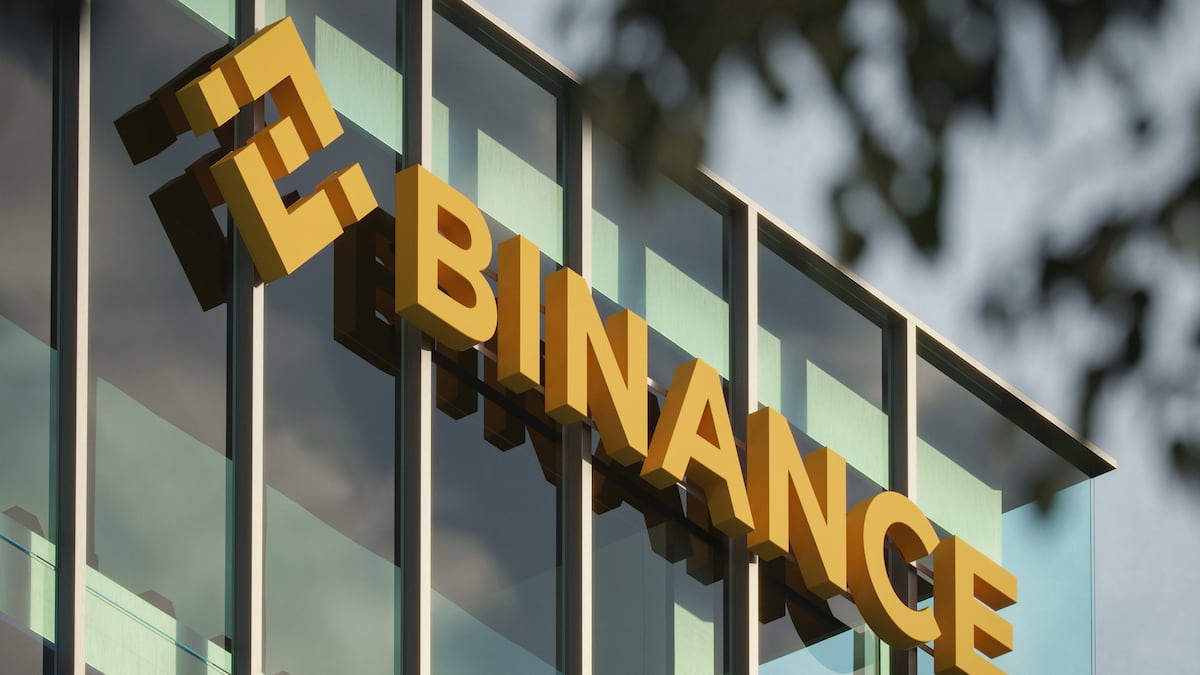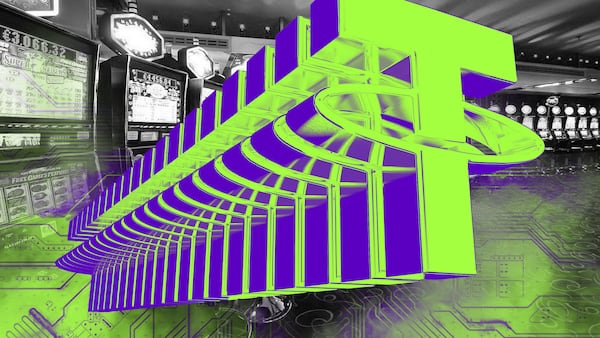- Binance's decision to omit TUSD from its so-called Launchpool program might have contributed to the stablecoin losing parity with the dollar.
- Demand for stablecoins is heavily tied to their utility on Binance, according to Kaiko.
TrueUSD, the fifth largest stablecoin by market value, has been slipping against the dollar.
Dubbed TUSD, the stablecoin started falling on January 9 and plummeted to a low of $0.926 on exchange Poloniex on January 16.
Stablecoin ratings agency Bluechip — which in June advised against the use of TUSD, ranking it a D, just above its lowest F rating — points to a few factors driving the recent depeg.
Stablecoins are cryptocurrencies designed to anchor to the value of other assets, typically the US dollar. Investors love them because they provide refuge from more volatile digital assets.
Exclusion from Binance Launchpool
Binance’s decision to omit TUSD from recent so-called Launchpool projects Manta and AltLayer — while scrapping promotions for zero-fee trading for the stablecoin — has put pressure on TrueUSD.
Launchpool allows participants to deposit, or stake, certain tokens, like Binance-affliated BNB, First Digital’s FDUSD, and TUSD, in exchange for accumulating rewards in the form of new tokens, shoring up liquidity in the process.
“For unclear reasons, Binance’s two Launchpools last week only offered staking of BNB and FDUSD, kicking out TUSD,” data analytics firm Kaiko said in a report on Monday.
“Exclusion from the Launchpools is indicative of Binance’s reducing support” for the TrueUSD stablecoin, Bluechip wrote in its report.
The move is “prompting trades to sell TUSD for FDUSD.”
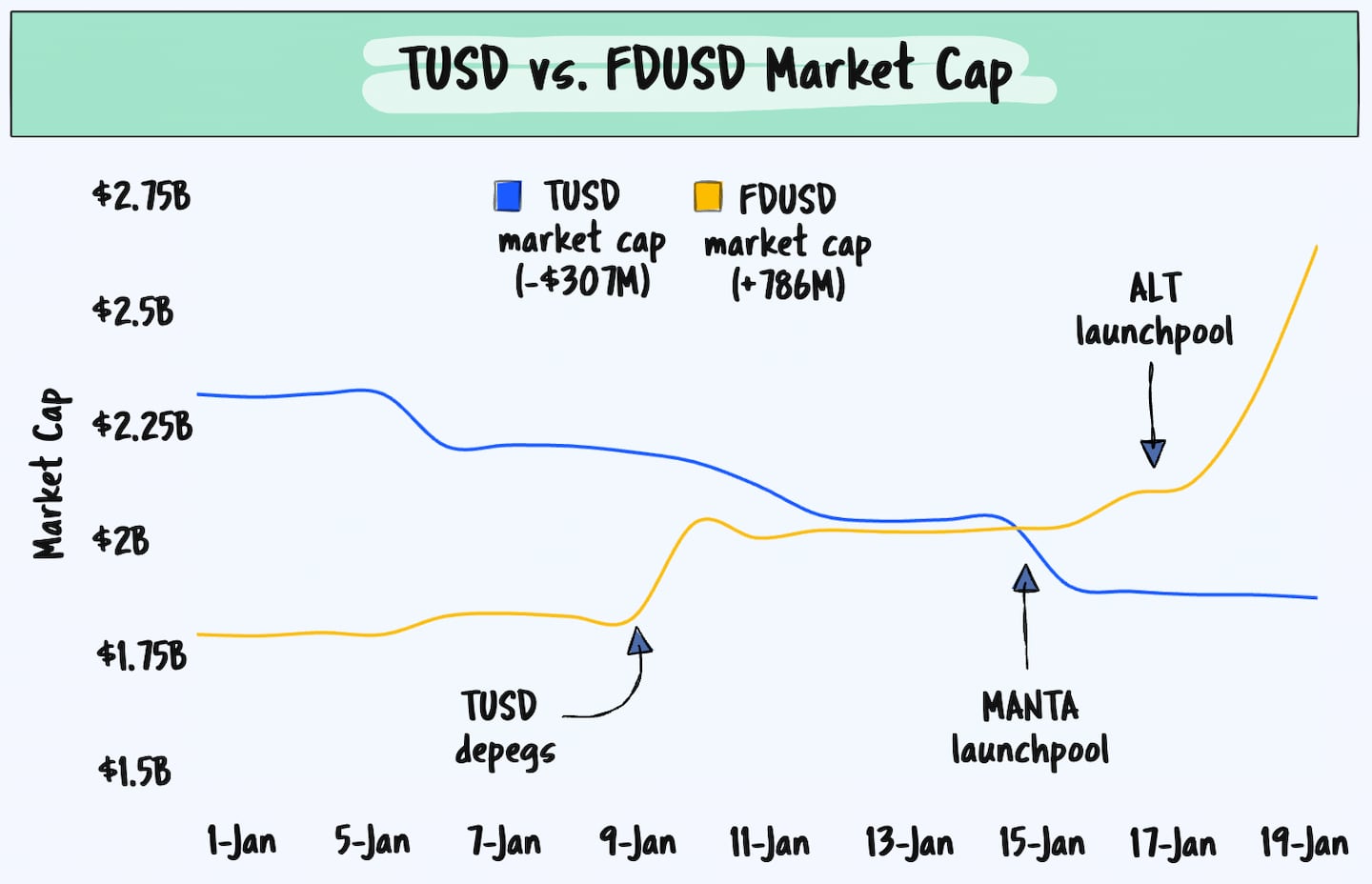
Indeed, First Digital’s stablecoin FDUSD has seen a $786 million in gains following TUSD’s slip from the $1 peg, while TUSD’s market share has fallen to 1.4%, losing $307 million.
TUSD’s total circulating supply has slipped to about $1.8 billion.
Meanwhile, the total circulating supply of all stablecoins is up 2.3% to about $133 billion in year-to-date terms, DefiLlama data shows.
“We have observed recent community mining activities associated with Binance Launchpool, which have led to short-term arbitrage opportunities,” TrueUSD wrote on January 18 on X, pointing to a “normal aspect of market dynamics and liquidity adjustments.”
But Bluechip cast doubt on this explanation, saying the depeg had begun a week before Manta and Altlayer pools launched on January 15 and 17, respectively.
Another reason for TUSD’s recent volatility could be linked to Binance stopping its zero-fee trading promotion with the stablecoin.
Binance consistently accounts for over 99% of TUSD’s volume, according to data analytics firm Kaiko.
“Despite high volumes for FDUSD, both stablecoins have largely failed to catch on for use beyond Binance’s zero-fee pairs,” Kaiko said.
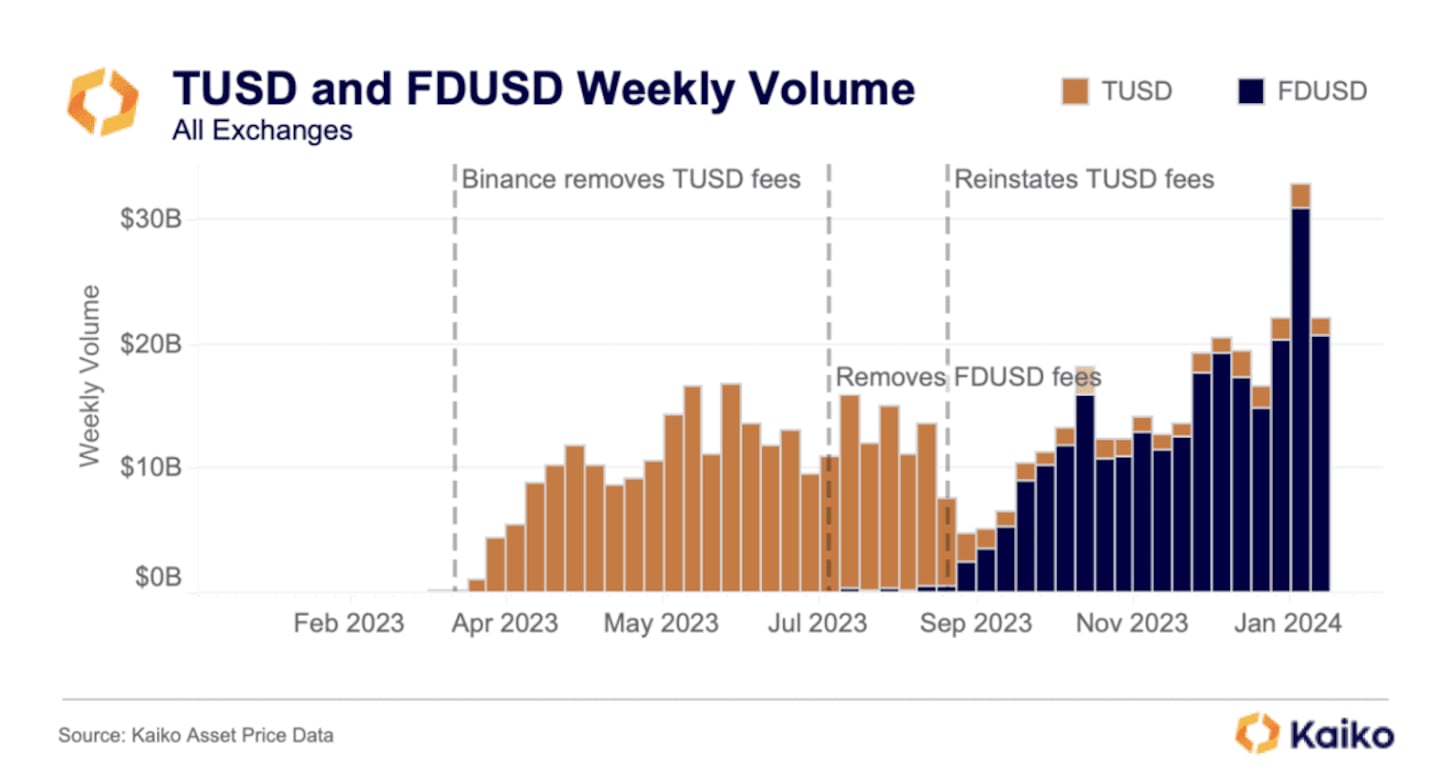
“There had been about $150 million of net TUSD selling,” leading up to the announcement, Kaiko said.
The data analytics firm measures this using what’s called Cumulative Volume Delta, or CVD.
This trading indicator adds up the differences between the buying and selling volumes over time to help investors understand the relationship between price moves and trading volume.
A negative CVD means there are more sellers in the market.
This abundance of selling led to a “fairly common TUSD depeg,” Kaiko said, which “escalated as soon as users realised that TUSD’s top use case had vanished.”
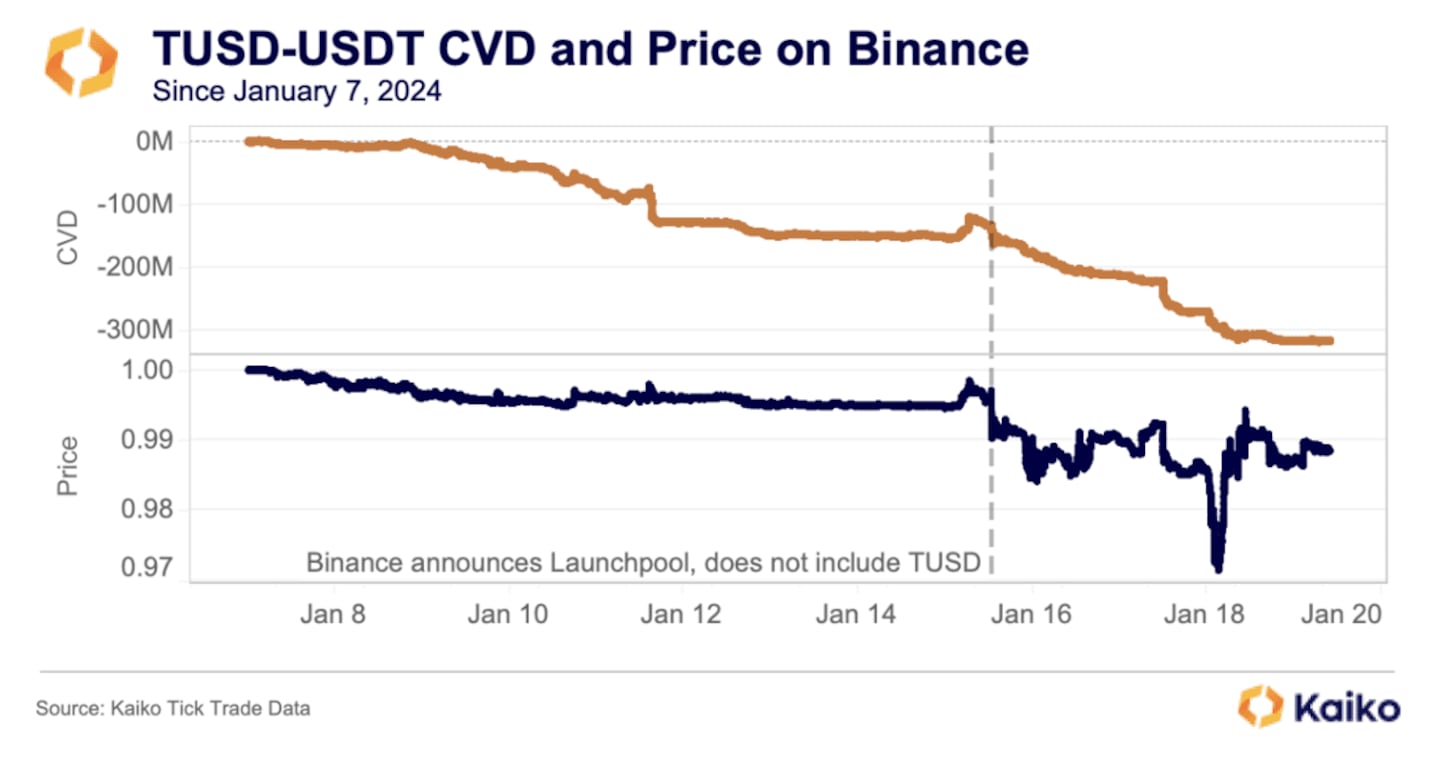
Lack of Transparency Around Reserves
TrueUSD says it has the reserves to back TUSD, and uses an attestation process to prove it.
But the accounting agencies it uses, The Network Firm and MooreHK, do not use humans to manually verify the source data, Bluechip said.
“The attestations are fully-automated reports, generated in real-time using data feeds from third parties,” it wrote.
TrueUSD did not immediately return a request for comment on the Bluechip report, but has countered questions about its reporting methods.
“Regular attestations are ongoing as part of our standard operations, and any claims suggesting otherwise are incorrect,” TUSD wrote last week on X.
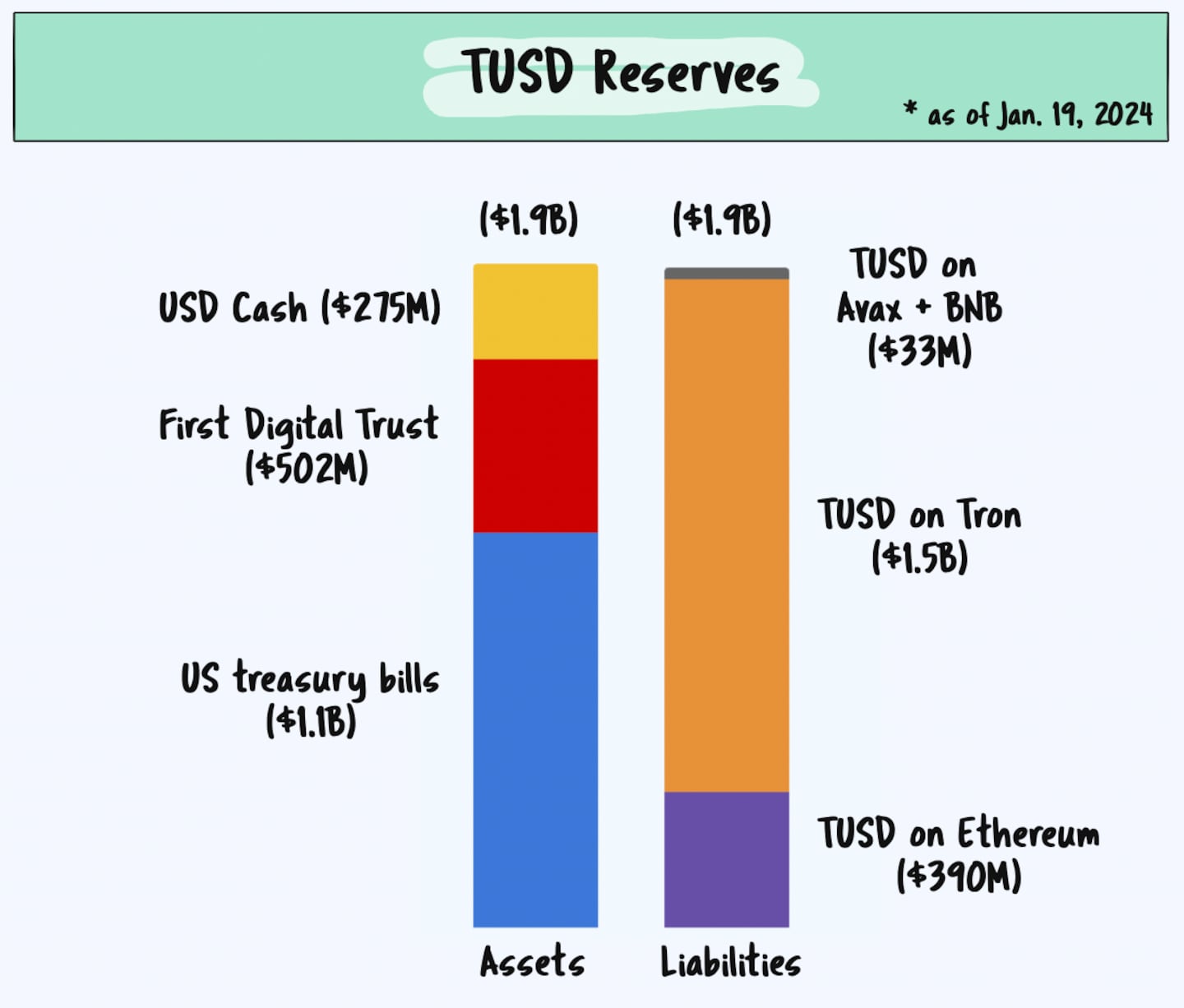
Security concerns
“Poor security practices at entities associated with TUSD do not instil confidence among TUSD holders,” Bluechip wrote.
TrueUSD said in October it experienced a data breach at a third-party vendor.
A British Virgin Island-incorporated consortium called Techteryx bought TrueUSD from Archblock in 2020. In July, TrueUSD said Techteryx will take over its management and all offshore operations.
Bluechip noted that “details about the company’s ownership and management team have not been disclosed.”
Justin Sun, who was mentioned in a lawsuit last year as a potential buyer of TrueUSD around the time of the 2020 purchase, has repeatedly denied any involvement with TrueUSD or Techteryx.
Sun told DL News last year: “The lawsuit has nothing to do with me,” and emphasised that the legal action involves a former employee of Archblock, not Sun himself or his blockchain company, Tron.
Stablecoins have recently come under fire, especially the popular USDT coin issued by Tether.
The United Nations said the stablecoin plays a major role in money laundering for organised crime groups across Southeast Asia.
Tether has pushed back against the 106-page UN report.
Crypto market movers
- Bitcoin fell 2.3% from Sunday to around $40,860.
- Ethereum dropped 3.7%, to trade just above $2,370.
What we’re reading
- EigenLayer eyes new security model — DL News
- Here’s how JPMorgan, Jane Street and others are managing spot Bitcoin ETFs — DL News
- Global Crypto Ownership Grew To 580,000,000, Bitcoin And Ethereum Leads — Milk Road
- Coinbase CLO Rips U.S. GAO Report On Crypto Sanctions Evasion — Milk Road
- Solana Stablecoin Transfer Volume Hits Record $300 Billion in January — Unchained
Sebastian Sinclair is a markets correspondent for DL News. Have a tip? Contact Seb at sebastian@dlnews.com. Adam Morgan is a markets correspondent at DL News. Reach him at adam@dlnews.com.
